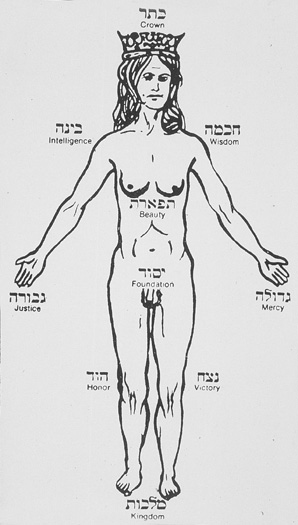Separation of the Sexes

After the separation of the sexes, the originally androgynous or hermaphroditic, bisexual, male-female (Hebrew: זָכָ֥ר וּנְקֵבָ֖ה zâkâr û -neqevâh) human being could only develop in a one-sided form as a male (Hebrew: אִישׁ isch "man, husband") or female (Hebrew: אִשָּׁה ischah "woman, wife"; pl. נָשִׁים "naschim"); man became a single-sex being.
Only the two lowest members of man, the etheric body and the physical body, are affected by the separation of the sexes, but each embodies opposite sexes. If the physical body is male, the etheric body is female and vice versa. In the course of the repeated earth lives of the human being, the sex usually changes with each incarnation, although this rule is often broken. However, a maximum of seven earth lives with the same gender follow each other.
Biological background
Whereas in asexual reproduction the offspring is genetically largely identical and thus a kind of biological immortality is ensured, in sexual reproduction the interaction of two partners of the same species but of different gender types, through the associated exchange of genomes, leads to a rapidly progressing differentiation, through which the individual being with its unique genetic particularity is, however, also necessarily subject to biological death. Through the necessity of mate choice, among other things, the development of the senses was decisively promoted and an abundance of completely new behavioural patterns and a stronger social bond could emerge.
Literature
- Rudolf Steiner: Aus der Akasha-Chronik, GA 11 (1904 - 1908), Kapitel Die Trennung in Geschlechter English: rsarchive.org German: pdf pdf(2) html mobi epub archive.org
- Rudolf Steiner: Die Tempellegende und die Goldene Legende , GA 93 (1991), ISBN 3-7274-0930-4 English: rsarchive.org German: pdf pdf(2) html mobi epub archive.org
- Rudolf Steiner: Geisteswissenschaftliche Menschenkunde, GA 107 (1988), Zehnter Vortrag, Berlin, 8. Dezember 1908 English: rsarchive.org German: pdf pdf(2) html mobi epub archive.org
- Rudolf Steiner: Das Ereignis der Christus-Erscheinung in der ätherischen Welt, GA 118 (1984), ISBN 3-7274-1180-5 English: rsarchive.org German: pdf pdf(2) html mobi epub archive.org
- Rudolf Steiner: Geistige Zusammenhänge in der Gestaltung des menschlichen Organismus, GA 218 (1992), ISBN 3-7274-2180-0 English: rsarchive.org German: pdf pdf(2) html mobi epub archive.org
 |
References to the work of Rudolf Steiner follow Rudolf Steiner's Collected Works (CW or GA), Rudolf Steiner Verlag, Dornach/Switzerland, unless otherwise stated.
Email: verlag@steinerverlag.com URL: www.steinerverlag.com. Index to the Complete Works of Rudolf Steiner - Aelzina Books A complete list by Volume Number and a full list of known English translations you may also find at Rudolf Steiner's Collected Works Rudolf Steiner Archive - The largest online collection of Rudolf Steiner's books, lectures and articles in English. Rudolf Steiner Audio - Recorded and Read by Dale Brunsvold steinerbooks.org - Anthroposophic Press Inc. (USA) Rudolf Steiner Handbook - Christian Karl's proven standard work for orientation in Rudolf Steiner's Collected Works for free download as PDF. |
